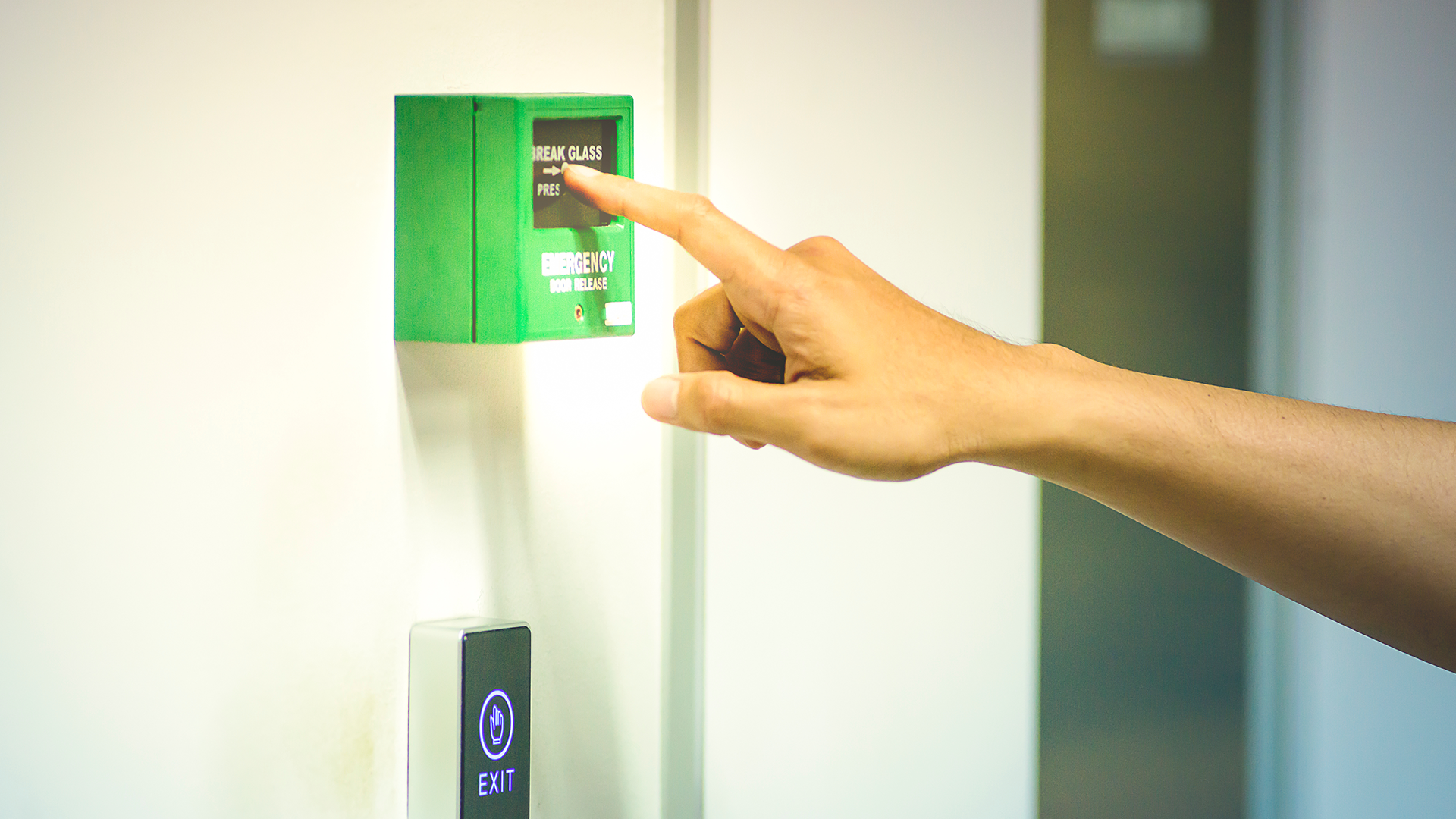Emergency Door Release Explained: Ensuring Safe Exits in the UK
Published by APEX Access Control on 22nd Jul 2025
Introduction
In any access control system, ensuring the safety of individuals is paramount. Emergency Door Release (EDR) units play a crucial role in maintaining the safety of building occupants during emergencies, especially in commercial and public spaces. This blog post will cover the importance of EDR units, their functionality, UK fire safety regulations, and key considerations for installation and maintenance.
What is an Emergency Door Release (EDR)?
An Emergency Door Release (EDR) is a safety device that allows an access-controlled door to be manually released in case of an emergency. Typically installed on fire exits or high-risk areas, EDRs ensure that doors can be opened quickly and easily to allow safe evacuation during a fire or other emergency situation. EDRs often come in a breakglass form, where the user physically breaks a glass to activate the mechanism, allowing the door to unlock.
How Do EDRs Work?
- Manual Override: EDRs are designed with a manual override function, enabling doors to be unlocked even if the access control system is engaged. This ensures that in an emergency, such as a fire, doors can be opened without delay.
- Integration with Fire Alarm Systems: In many systems, the EDR is wired to the building's fire alarm system. When the fire alarm is triggered, the EDR automatically releases the door lock to facilitate a safe exit.
- Key Components: EDR units typically consist of a break-glass unit or a push-button mechanism that will unlock the door or release the latch, allowing access in case of an emergency.
Versions of EDRs: Single, Double, and Triple Pole
EDRs are available in various versions, with single, double, and triple pole configurations. Each version serves different purposes based on the specific requirements of the installation.
- Single Pole (SP): The simplest configuration, used to break only one circuit, typically the positive or negative line of the lock.
- Double Pole (DP): Breaks both the positive and negative lines of the lock, ensuring complete isolation of the circuit. This is considered best practice, especially for maglocks, to prevent lock malfunction due to incomplete circuit release.
- Triple Pole (TP): Used in more complex systems where three circuits need to be isolated, often for larger systems or systems with multiple entry points.
Why Are EDR Units Required for Safety in the UK?
- Fire Safety Regulations (e.g., Regulatory Reform (Fire Safety) Order 2005): These regulations stipulate that fire exit doors must be able to be opened by anyone, including non-staff members, in an emergency situation. This is where EDRs come in.
- Health and Safety Executive (HSE) Guidelines: EDRs are essential in complying with workplace safety laws, ensuring that employees and visitors can safely evacuate during a fire or other emergency.
- BS EN 60839-11: This British Standard outlines the performance requirements and testing methods for emergency door releases, ensuring that they provide a reliable solution for safe exits in case of emergencies.
Best Practices for Installing and Maintaining EDR Units
Installation:
- Location: EDR units should be installed near fire exit doors and access-controlled entry points. Ensure they are placed at a height that is easily reachable.
- Accessibility: The manual release mechanism must be accessible to everyone, including people with disabilities. Ensure that the device complies with the DDA (Disability Discrimination Act) requirements.
- Integration: EDR units should be integrated with your existing access control and fire alarm systems to ensure they function seamlessly during an emergency.
- Maglock Wiring: Best practice dictates that maglocks should always break both the positive and negative lines using a double-pole EDR. This ensures that the entire lock circuit is disengaged, preventing malfunction during emergencies.
Maintenance:
- Regular Testing: EDR units should be tested monthly to ensure they are functioning correctly. Regular checks should be made to ensure that the release mechanism is not obstructed and that the unit is operational.
- Battery Check: For wireless or battery-powered EDR units, regular battery checks are essential to prevent failure during emergencies.
- Compliance Inspections: Have your access control system, including EDR units, regularly inspected by certified professionals to maintain compliance with fire safety regulations.
Wiring Diagrams: How to Wire Your EDR
It’s essential to understand how EDRs function in real-world wiring setups. The diagrams below show before and after states — what the circuit looks like when the system is idle, and what changes when the glass is broken.
Single Pole – Breaks One Power Line
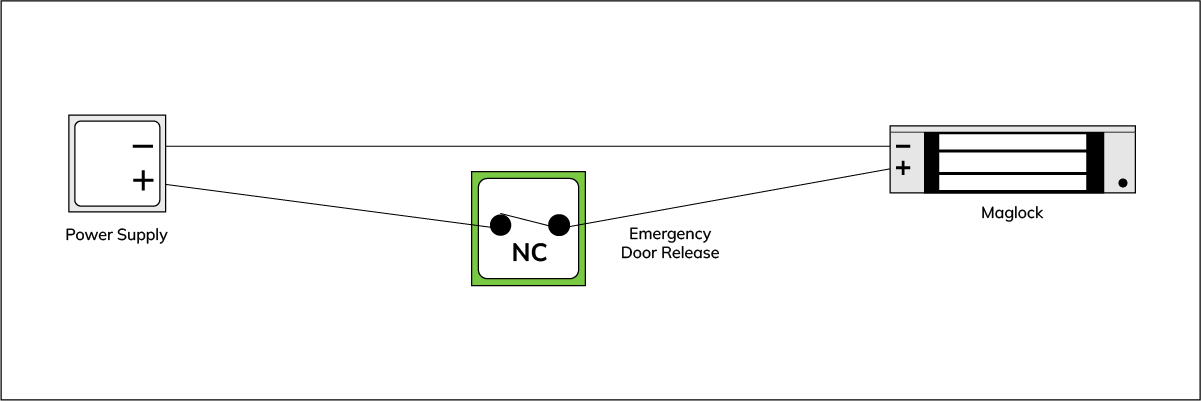
Before – Idle State: Power flows through the N/C contact to the maglock. The lock remains engaged.

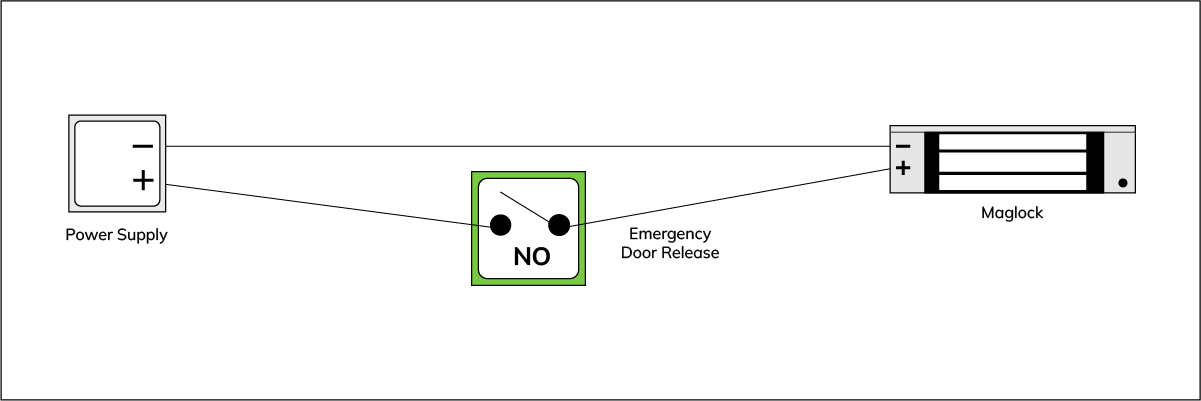
After – Activated State: The contact opens, breaking the circuit. The maglock is de-energised and releases.
Double Pole – Breaks Positive and Negative
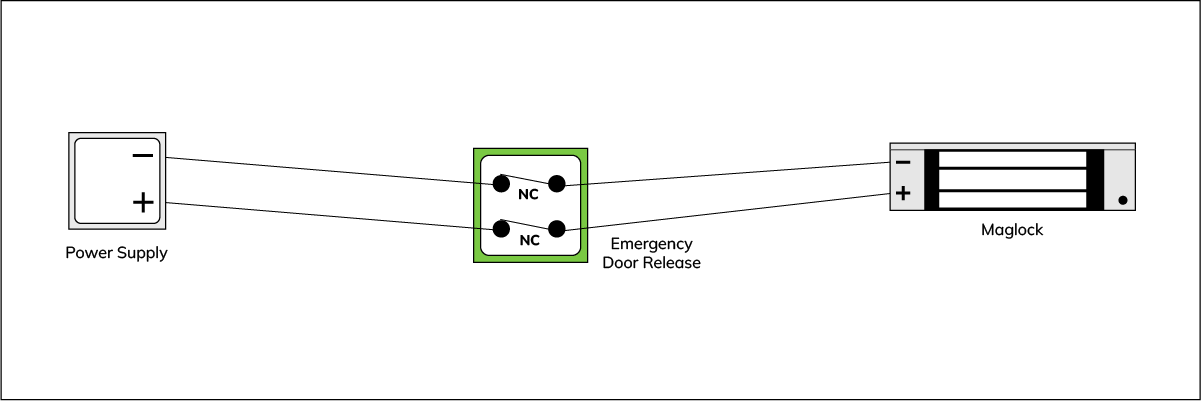
Before – Idle State: Both the +V and –V lines are closed through N/C contacts, powering the maglock.
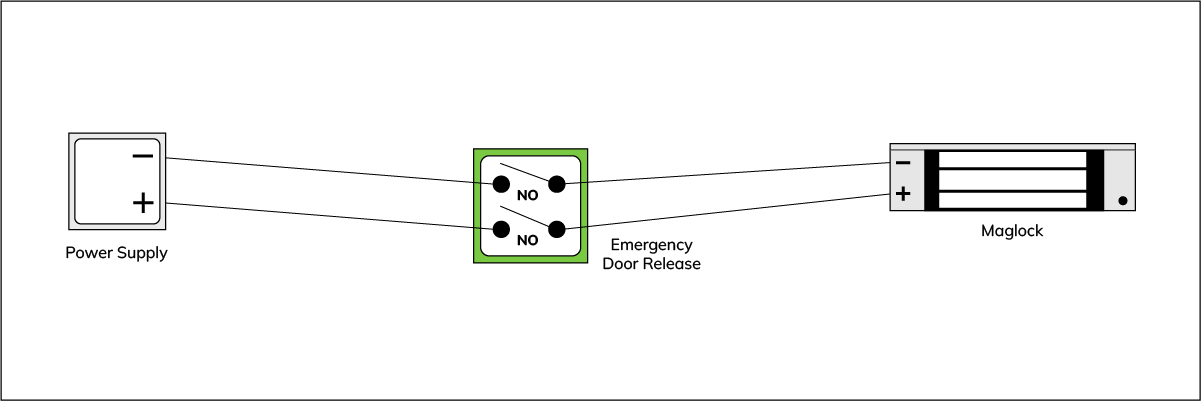
After – Activated State: Both lines are broken. The maglock is fully isolated and releases safely.
Triple Pole – Power + Auxiliary Trigger
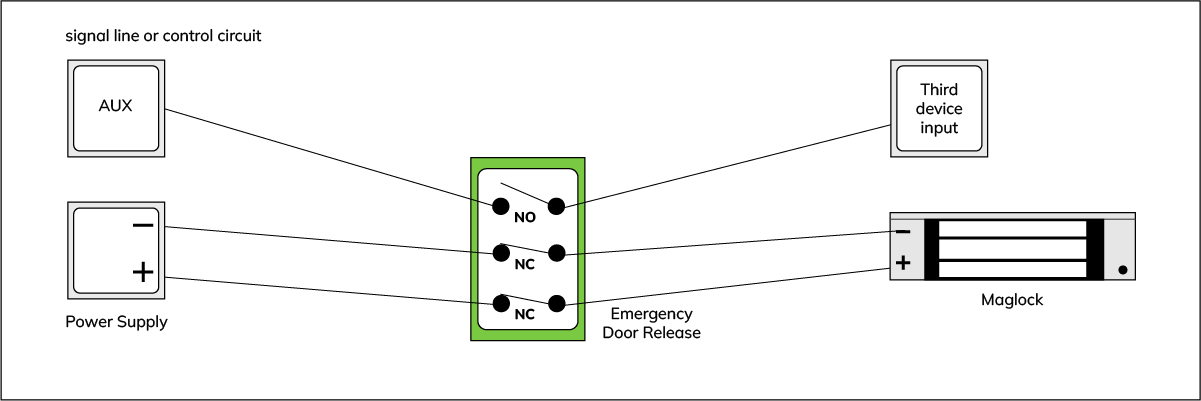
Before – Idle State: Two N/C contacts power the maglock. A third N/O contact is open and unconnected.
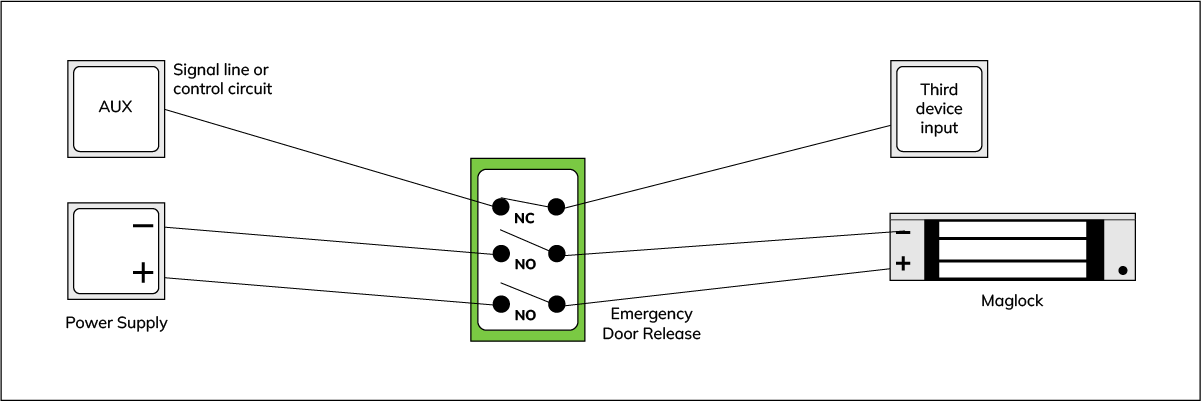
After – Activated State: The power contacts open. The N/O contact closes, sending a signal (e.g. to a fire panel or sounder).
Single Throw vs. Double Throw: What’s the Difference?
When wiring an EDR, it's important to understand what “throw” means. This isn’t just technical jargon — it refers to how many output paths are available from a single input terminal.
Throw is a physical characteristic of a switch or contact block, just like “pole.”
- A pole controls how many separate circuits the device operates.
- A throw determines how many output paths each pole can connect to.
Single Throw (ST)
- One input terminal connects to one output path.
- The circuit is either open or closed — there’s no alternate path.
- Most basic EDRs use Normally Closed (N/C) contacts that simply break a single line to the maglock when triggered.
- This is known as a Single Pole, Single Throw (SPST) setup.
Example:
A standard break-glass unit that cuts power to the maglock using a single N/C contact.
Double Throw (DT)
- One input terminal can switch between two outputs:
- Normally Closed (N/C) when idle
- Normally Open (N/O) when triggered
- This gives you more flexibility, as you can break a power line and send a signal to another device using the same contact block.
- Common in resettable EDRs or advanced installations.
- Known as Single Pole, Double Throw (SPDT) or Double Pole, Double Throw (DPDT) depending on how many circuits are involved.
Example:
An EDR that cuts power to the maglock via the N/C contact, and simultaneously sends a signal to a fire panel or sounder via the N/O contact.
Real-World Use: DPDT in EDRs
If your EDR has two contact blocks, and each one includes COM, N/C, and N/O, it’s a Double Pole, Double Throw (DPDT) device.
This allows you to do the following at the same time:
- Break +V to the maglock
- Break –V to the maglock
- Trigger a sounder or fire panel input
So you're controlling two circuits and each has two output paths — one that opens (N/C) and one that closes (N/O) when the glass is broken.
Note: Whether you use the N/C or N/O contact will depend on the requirements of the device you're connecting to. For example, maglocks typically use the N/C path to break power, while fire panels or sounders may require an N/O contact to close the circuit and trigger an input when the EDR is activated.
In a nutshell:
A single throw contact has just N/C and COM — the circuit is either connected or broken.
A double throw contact has N/C, N/O and COM — allowing it to break one circuit and trigger another at the same time.
Conclusion
Emergency Door Release units are a vital safety feature in any building with access control systems. Ensuring they are correctly specified, installed, and maintained is not just a legal obligation under UK fire safety regulations — it's a critical part of protecting lives during an emergency.
At APEX Access Control, we supply a full range of reliable, compliant EDR units — including single, double, and triple pole models — and we’re happy to offer technical advice to help you choose the right solution for your project.
Need help selecting the right EDR or wiring method?
Get in touch with APEX today for expert support and competitive trade pricing.

